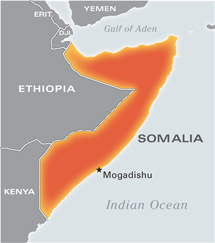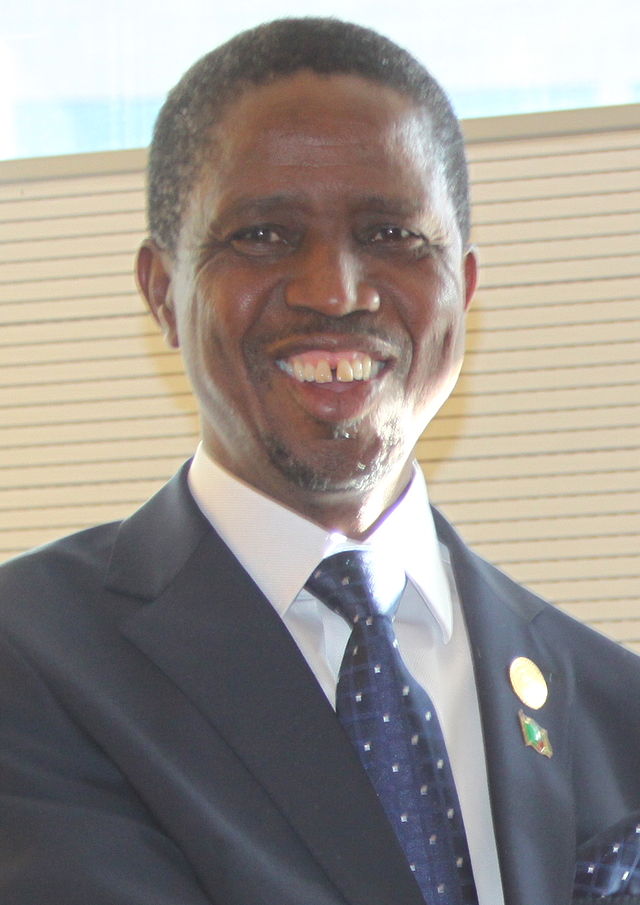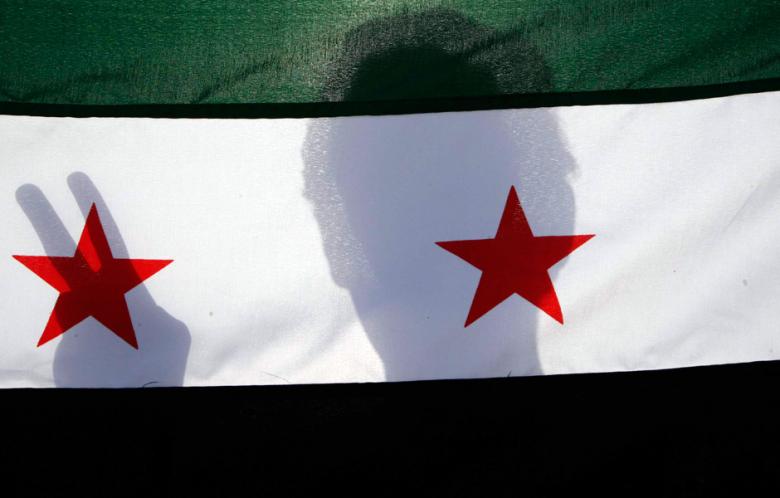INTRODUCTION
In this essay I would like to focus on a case study of Islamism in failed state of Somalia. The most powerful and dangerous Islamic actor in Somalia is Al-Shabaab, which is ruling now over half of Somalia country.
SOMALIA – BACKGROUND OF THE CONFLICT
Somalia was created in 1960 by the merger of British Somaliland Protectorate and the colony of Italian Somaliland. The United Republic of Somalia was ruled by a democratic government for nine years until it was toppled by a military coup. Consequently, Major General Muhammad Siad Barre took power. Barre established a socialist state, until opposition clans overthrew him in 1991. After Barre’s expulsion, northern clans formed the de-facto, self-declared Republic of Somaliland, which, though internationally unrecognized, has maintained a relatively stable existence. In the south, however, violence between rival warlords killed thousands of civilians, prompting the UN Security Council to sponsor a U.S.-led intervention in 1993. The intervention ended shortly after a brutal firefight in the streets of Mogadishu led to an unsuccessful incident that has become known as Black Hawk Down (Cohn 2010). In Somalia were fourteen separate governments between 1991 and 2010.
Some foreign states are also active in this conflict. On 5th of June 2006, the Union of Islamic Courts (UIC) defeated a group of CIA-backed warlords and took control of Mogadishu. In December 2006, Ethiopia, with U.S. backing, intervened to end the UIC’s rule and installed theTransitional Federal Government (TFG). The intervention of Ethiopian troops was the main case of Al-Shabbab’s radicalization. In 2008 the United States, the UN, the African Union, the League of Arab States and other actors endorsed the UN-sponsored Djibouti Peace Process. This led to the election of Shaykh Sharif Shaykh Ahmad, a moderate figure in the UIC, as president of the TFG (Cohn 2010). Unfortunately, the Djibouti Process did not end the civil war. Islamists created new fundamentalist Islamist group, Hisbul Islamiyya (HI). Nowadays Al-Shabaab controls most of the south part of Somalia. Extremist voices within the UIC, particularly from Al-Shabaab, claiming affiliation with Al-Qaeda, worried many in the West.
“Somalia’s frail Transitional Federal Government has struggled ineffectually to contain a complex insurgency that conflates religious extremism, political and financial opportunism and clan interests. As the result, southern Somalia remains a patchwork of fiefdoms controlled by rival armed groups — a political and security vacuum in which no side is strong enough to impose its will on the others.” (UN Report 2010: 6).
ISLAMISM IN FAILED STATES
We should consider that there are many differences between Islamism implemented “from above” (e.g. Iran) and Islamism in weak and failed states (e.g. Afghanistan). Somalia is for many years a really weak state, where the government has not monopoly of violent. Here are some of the specific signs of Islamism in failed states:
In the case of a failed state Islamist actors generally do not need to define themselves vis-a-vis existing political authority. But neither will they enjoy the relatively luxurious circumstances of political opposition, where one can criticises the government without being required to implement alternatives. However once in power their abilities and religion identity will be put to the test faced the realities of running a country (Mandaville 2007: 198).
In failed states Islamist are often entering into odd alliances to achieve short and medium term goals (Mandaville 2007: 198). Although Al-Shabaab’s ideology is based on Islam religion, it recruits fighters from foreign countries, which are fighting just for money not for religion (Bengali 2008). There is even the evidence that few Americans has gone to Somalia with intention to fight there as well (Schmitt 2010). Al-Shabaab is also entering into alliances with other Islamic organisations in Somalia and local warlords to achieve their goals. Nevertheless, if Al-Shabaab is ruling the country, their future cooperation is not clear.
Islamist actors that are well organised, funded and managed may emerge as parallel service providers or even begin to resemble “shadow governments” (Mandaville 2007: 199). That is what Al-Shabaab tries to do. It forms Islamic administration in conquered towns (AllAfrica 2009). In those towns very strict way of Sharia law is implemented. Islamic actors in weak state often “worked to fill the void left by the absent state, and so build for themselves an enormous pool of social capital and popular legitimacy.” (Mandaville 2007: 199). Lebanese Hezbollah is probably the most striking example of this approach. Hamas does this and Taliban as well. Some analysts said that Somalia resembling Afghanistan under Taliban rule. They are supposed to use the same tactic as Taliban did in the beginning of 90s (Journal Neo).We can see a lot of similarities but Al-Shabaab doesn’t provide social service which is missing at all. Nowadays we can see that Al-Shabaab is losing popular support (Amisom 2011). It is possible, that weakening popular support could mark the beginning of the decline for Al-Shabaab.
To conclude, we can say that apart from few exceptions, Al-Shabaab is acting like typical Islamic organisation in failed state.
AL-SHABAAB
Al-Shabaab was founded by former members of Al-Iltihad Al-Islami, a militant group active in Somalia between 1991 and 1997. Elements of Al-Shabaab appear to have been independently active from approximately 2002, but the group first acquired a public profile in 2005, when it established a base in a former Italian cemetery in Mogadishu. In 2006, the group emerged as the militant wing of the Union of Islamic Courts (UIC). Following the defeat of UIC by Ethiopian forces in January 2007, Al-Shabaab adopted an increasingly independent trajectory. In January 2009 Sheikh Sharif Sheikh Ahmed was elected as a president. Al-Shabaab leaders describe President Sharif and the Transitional Federal Government as “apostates” and have continued to attack them with guerrilla tactics, improvised explosive devices and targeted killings.
Organizationally, Al-Shabaab remains a relatively loose and heterogeneous organization, serving as an umbrella for self-professed “jihadists”, clan militias, business interests and foreign fighters. Decision-making in Al-Shabaab is undertaken by a collective leadership structure (UN Report 2010: 14).
Goals
“Its principal objective is to establish a Somali Caliphate of the Wahhabi Islamic sect in Somali-inhabited regions of the Horn of Africa through and by way of militarized intervention by taking advantage of the vacuum in Somalia’s failed statehood and by using the Ethiopian and United States strategic interventions in Somalia as rallying points and a motivating element among Somali youth as a driving force for recruitment and national sentiment of discontent.” (Abdisaid 2008). Recent years Al-Shabaab has been more concentrated on the foreign countries, talking about global Jihad. As Abu Mansor Al-Amriki (2008) – an important member of Al-Shabaab from US – said: “We stress here that we are striving to establish the Islaamic Khilaafah from East to West after removing the occupier and killing the apostates. We will do this while holding on to the Book and the Sunnah.”
In a February 2010 press conference, Al-Shabaab announced it will be aligning itself with Al-Qaeda „to confront the international crusaders and their aggression against the Muslim people.“ (Adl 2011). In comparison with others Islamic groups in Somalia like UIC, Al-Shabaab is much more dangerous than others Somalia Islamist groups (like Islamic Courts) because of the global jihadist vision.
Ideology
On one level, the conflict in Somalia represents a struggle between groups with competing political and ideological agendas. Al-Shabaab and Hizbul Islam both profess Salafi versions of Islam, while ASWJ represents a number of Sufi branches of the Shafi’i school. On another level, however, the conflict is a product of the clan dynamics that have shaped the Somali civil war for the past 20 year. (UN Report 2010: 11). In July 2008, clashes broke out between ASWJ and Shabaab militias in a number of locations in central and south-western Somalia where Al-Shabaab had attempted to ban Sufi religious practices. By late 2009, ASWJ had emerged as the largest and most effective government-aligned fighting force in southern Somalia. (UN Report 2010: 12).
Connection with Al-Qaeda
It remains unclear how deep the connection between Al-Shabaab and Al-Qaeda is. The expert’s opinions differ. However, there is evidence that these groups are in contact. That is proved by proclamations of their leaders. UN Report states (2010: 15):“Extremists within Al-Shabaab seek, with limited success, to align the organization more closely with Al-Qaida. Several of the group’s leaders have trained or fought overseas, principally in Afghanistan, and have introduced tactics employed in those conflicts to Somalia.”
In August 2008, Shabaab spokesman Sheikh Mukhtar Robow said that Shabaab was „negotiating how we can unite into one“ with al-Qaeda. He continued, „We will take our orders from Sheikh Osama bin Laden because we are his students.“ (in Gartenstein-Ross, Gruen 2009). Zawahiri responded on November 19, 2008, with video in which he called Shabaab „my brothers, the lions of Islam in Somalia.“ He urged them to „hold tightly to the truth for which you have given your lives, and don’t put down your weapons before the mujahid state of Islam [has been established] and Tawheed has been set up in Somalia.“(in Gartenstein-Ross, Gruen 2009).
According to Hanson 2010: „Experts say there are links between individual al-Shabaab leaders and individual members of al-Qaeda, but any organizational linkage between the two groups is weak, if it exists at all. (…) The strongest tie between Al-Shabaab and Al-Qaeda seems to be ideological.“ However the connections and contact between these two organisations could be dangerous.
THE CHANGE OF TACTIC
Al-Shabaab’s tactics have evolved over time. It had started insurgency involving rather guerrilla tactic, but lately it turned to purely terroristic actions. We cannot say when exactly Al-Shabaab changed its approach. After my research, I divided the time of Al-Shabaab’s activity into two periods. First begins in 2006 – this is the year when Al-Shabaab started operated as independent group (according to UN report 2010) and ends in 2008. In 2008 the group started with terrorist attacks outside Somalia. In this year it was listed as terrorist group by USA.
2006 – 2008
“When Al-Shabaab began its insurgency in late 2006, it used classic guerrilla tactics – suicide bombings, shootings, ambushes and targeted assassinations to oppose the Somali government and what it perceives as its allies, from aid groups to the Ethiopian military to African Union peacekeepers. “ Much of the violence was concentrated in Mogadishu (Hanson 2010).
Many attacks are recorded from this period. March 26, 2007: Al-Shabaab claimed responsibility for the suicide attack detonated a car bomb near the Ethiopian soldiers. This was the first suicide attack in Mogadishu. Al-Shabaab reports that seventy two soldiers died in that attack and that hundreds more were injured (Harnisch 2010: 44). In the year 2007 Al-Shabaab was already very active. It assassinated at least 17 highly important people – eg. the Chief of Intelligence Ahmed Mohamed Odaysge (May 21), the Deputy Chairman of Ahmed Hassan (July 16), judges and many others (Harnisch 2010: 50). There is no evidence of any attack in foreign countries until 2008. In this period Al-Shabaab was acting like a typical urban guerrilla.
2008 – 2011
In 2008, Al-Shabaab began using political strategies to reach out to the Somali public with a series of well-choreographed town visits. Al-Shabaab would hand out food and money to the poor, give criminals quick trials with „mobile Sharia courts,“ and attempt to settle local disputes. As the group sought to take control of towns in southern Somalia, it began to use political strategies as well. Before a particular town was captured, insurgents had meetings with local clan leaders to convince them that their intentions were good (Hanson 2010).
However, the group continued to launch suicide attacks. Apart of this they extended their area of action to neighbouring countries. On 11 July 2010 Al-Shabaab carried out twin bombings in Uganda, country participating in Somalia peacekeeping efforts. It was at the venues, where crowds gathered to watch the broadcast of the World Cup finals. 74 people were killed and 85 injured (Adl 2011). “The attacks point to an internationalization of al-Shabaab’s terrorist activities, which could destabilize East Africa (Atlantic) and unleash repercussions abroad.” (Hanson 2010). In this period Al-Shabaab is also getting closer to Al-Queda.
Another newly using tactic is propaganda – foremost internet. The most active online Al-Shabaab outlet is alqimmah.net. This page is part of Al-Sabaab’s propagation mechanism. On 22 July 2009, alqimmah.net posted a 42-minute audio tape. The recording casts President Sharif as the leader of a heretical regime, and AMISOM forces as infidel invaders, and urges listeners to support jihad against them. The propaganda section of Al-Shabaab subsequently claimed to have distributed this widely throughout Somalia (UN Report 2010: 29). “On 15 August 2009, al-Qimmah posted a link to a book entitled The Science of Explosions and Explosives. The intention of the posting was apparently to make available to Shabaab supporters and sympathizers knowledge pertinent to bomb-making.” (UN Report 2010: 29). They also posted fatwa against Djibouti peace process or jihad video to encourage their supporters.
Al-Shabaab’s military forces include three main categories of fighters (UN Report: 15):
• A core force comprising fewer than 2,500 Somalis and several hundred foreign fighters.
• A larger number of local clan militias aligned with Al-Shabaab, but not readily deployable for operations outside their home areas.
• Irregular fighters engaged for specific operations on a “pay-as-you-go” basis.
Al-Shabaab compensates for these relatively small numbers, and the variance in quality of its forces, with the mobility of its forces and its ability to concentrate them across considerable distances on short notice and to great effect.
A website that claims support for Al-Shabaab published a detailed military strategy aimed at helping militants pull off gains without suffering losses. The five-page plan urges fighters to divide into units and „not to engage in a face-to-face battle — only hit-and-run attacks — to preserve energy.“ It also counselled fighters to carry out ambushes along main roads and in towns.“There is no doubt that those small units will have a major effect on the power and morale of enemy troops on the front lines, something that will stop them from continuing their advance,“ the document continued. (Somalimemo.net in Kaxda 2011)
In my opinion the main cause of radicalization of Al-Shabaab was that more foreign (especially Ethiopian) troops were implemented in Somalia conflict. Al-Shabaab is strongly against any foreign states trying to solve Somalia problems. They are even killing peacekeeping soldiers and humanitarian workers.
Losing popular support
Al-Shabaab has been losing the popular support. “The reason the holy warriors have failed to emerge victorious against the infidels is largely due to the bad relationship between the public and al-Shabab,” said Khalaf, whose remarks were carried on local radio. The comments by Khalaf amounted to an admission by al-Shabab leaders that the group has indeed been engaged in human rights abuses. Human rights groups have long accused al-Shabab of being guilty of harassment, killings, robbery and rape charges Al-Shabaab normally denies. (Amisom 2011). For example “Al-Shabaab punishers cut out the man’s tongue. In another recent incident Al-Shabaab gunmen killed two pastoralists near Kismayu for refusing to pay money demanded by the militant group.“ (Amisom 2011).
„Any organization that uses an ideology of fear cannot survive for long because the population will finally understand the hidden interests of its artificial war,“ said Barigye Bahoku (in Kaxda 2011), the spokesman of the African Union peacekeepers in Mogadishu, adding that Al-Shabaab’s strength „is at best a myth and artificial at worst.“
FROM INSURGENCY TO TERRORISM?
After the change in tactic we may ask a question: Can we still call Al-Shabaab insurgenncy or is it already a terroristic group? I haven’t got enough space here to study deeply the differences and definitions between insurgency and terrorism. It is not the goal of my essay. I just would like to mention it in connection with changed tactic in Al-Shabaab’s acting.
There is only a very tiny border line between these terms. Also subjective feelings play important role in attempts to classify various groups as insurgency or terrorism. “The term ‘freedom fighter’ suggests heroism while ‘terrorist’ conveys cowardice.” (Kiras 2010: 187). According to Kiras, insurgency and terrorism shares the use of force to achieve a political end. Terrorism rarely results in political change on its own while insurgency attempts to bring about change through force of arms.
“Confusion often results from insurgent movements using terrorist tactics to achieve local results. Insurgency, unlike terrorism, is characterized by the support and mobilization of a significant proportion of the population. Individual insurgencies differ widely in terms of character (social, cultural, and economic aspects) and type (revolutionary, partisan, guerrilla, liberation, or civil war) but obtaining power and political control is the desired outcome. Finally, external physical and moral support for an insurgent cause is a prerequisite for success.” (Kiras 2010).
In the first period (2006-2008) there were no doubt that Al-Shabaab was acting like insurgency group (according to the tactic mention above). What about now? It is clear that Al-Shabaab is using terroristic tactic– e.g. terroristic attack in Ethiopia. Could we say that Al-Shabaab is insurgency using terroristic tactic? I am not sure about that, because as Kiras stated insurgency must have public support. Usually insurgents get its resources, food etc. from population. Al-Shabaab obtains many resources from abroad or forces the population to help them. The public support has been falling down really quickly. In my opinion Al-Shabaab is now in the middle of its way to become a pure terroristic group. As far as I can see, there is not any other way for Al-Shabaab then becoming a terroristic group. It is obvious not just from losing supporters, but also from more and more extremist ideology, containing fighting global jihad. I think the connection with Al-Qaeda is very dangerous and together, they could cause singnificant problems in Africa, America and Europe.
CONCLUSION
There is no doubt that Al-Shabaab is becoming more extremist group in both – tactical and ideological means. The shift turned out to be obvious in year 2008, when Al-Shabaab started with terroristic attacks in abroad and also announced that they are in contact with Al-Qaeda. Considering future of this organisation is not easy. Their weak point is a relation with the population. Al-Shabaab doesn’t offer anything to the population. It doesn’t provide social service, food and even security. In my opinion with good propaganda and strategy the government could defeat them. As Kaxda (2010) said: “Al-Shabaab may only appear strong because the Somali government, known as the Transitional Federal Government, is so weak.” However, there is still possibility that after defeat in Somalia Al-Shabaab could move to other state and joint fully to Al-Qaeda.
The situation should be solved as soon as possible because: „Over the last two years the situation has deteriorated into one of the world’s worst humanitarian and security crises.“ (Crisis Group 2008).
REFERENCES:
Abdisaid, A. (2008): The Al-Shabaab Al-Mujahidiin, A Profile of the First Somali Terrorist Organisation, in Institut für Strategie – Politik – Sicherheits – und Wirtschaftsberatung. Accessed 1. 5. 2011.
http://www.isn.ethz.ch/isn/Digital-Library/Publications/Detail/?ots591=0C54E3B3-1E9C-BE1E-2C24-A6A8C7060233&lng=en&id=55851
Adl 2011: International Terrorism Symbols Database – Al-Shabaab. Accessed 1. 5. 2011.
http://www.adl.org/terrorism/symbols/al_shabaab.asp
All Africa 2009: Somalia: Al-Shabaab Forms Islamic Administration in Strategic Town. Accessed 1. 5. 2011.
http://allafrica.com/stories/200905200681.html
Al-Amriki (2008): A Message to the Mujaahideen in Particular & the Muslims in general. Accessed 1. 5. 2011.
http://forums.islamicawakening.com/f18/abu-mansoor-al-amriki-american-mujaahid-somalia-9704/
Amisom (2011): Losing Streak – Public support fades for al-Shabab. Accessed 1. 5. 2011.
http://www.amisom-au.org/article-51
Bengali, S. (2008): Kenyan Islamist recruits say they did it for the money, in McClatchy. Accessed 1. 5. 2011.
http://www.mcclatchydc.com/2008/11/18/56098/kenyan-islamist-recruits-say-they.html
Cohn, J. (2010): Terrorism Havens: Somalia, in Council on Foreign Relations. Accessed 1. 5. 2011.
http://www.cfr.org/somalia/terrorism-havens-somalia/p9366
Gartenstein-Ross, D.; Gruen, M. (2009): Understanding Democracy, in Foundation for Defense of Democracies. Accessed 1. 5. 2011.
http://www.defenddemocracy.org/index.php?option=com_content&task=view&id=11787129&Itemid=326
Hanson, S (2010): Al-Shabaab, in Council on Foreign Relations. Accessed 1. 5. 2011.
http://www.cfr.org/somalia/al-shabaab/p18650#p3
Harnisch, Ch. (2010): The Terror Threat From Somalia, in Critical Threats. Accessed 1. 5. 2011.
http://www.criticalthreats.org/sites/default/files/pdf_upload/analysis/CTP_Terror_Threat_From_Somalia_Shabaab_Internationalization.pdf
International Crisis Group (2008): Somalia: To Move Beyond the Failed State.Accessed 1. 5. 2011.
http://www.crisisgroup.org/en/regions/africa/horn-of-africa/somalia/147-somalia-to-move-beyond-the-failed-state.aspx
Kaxda 2011: Somalia’s al-Shabab faces first serious threat after pro-government offensive makes gains.Accessed 1. 5. 2011.
http://www.kaxda.net/2011/04/16/somalias-al-shabab-faces-first-serious-threat-after-pro-government-offensive-makes-gains-2645128
Kiras (2010): Irregular Warfare: Terrorism and Insurgency, in Oxford University Press. Accessed 1. 5. 2011.
http://www.oup.com/uk/orc/bin/9780199548873/baylis3e_ch09.pdf
Mandaville, P. (2007): Global Political Islam, London, Routledge.
Shishkin, D. K. (2010): Is Al-Shabab the Somali Taliban? in Journal Neo. Accessed 1. 5. 2011.
http://www.journal-neo.com/?q=node/135
Schmitt, E. (2010): Islamic Extremist Group Recruits Americans for Civil War, Not Jihad, in New York Times. Accessed 1. 5. 2011.
http://www.nytimes.com/2010/06/07/nyregion/07shabaab.html
UN Report 2010: Report of the Monitoring Group on Somalia pursuant to Security Council resolution 1853. Accessed 1. 5. 2011.
http://somalitalkradio.com/2010/mar/un_report_somalia.pdf
Autor: Alena Hrušková, studentka bezpečnostních a strategických studií, FSS MU






